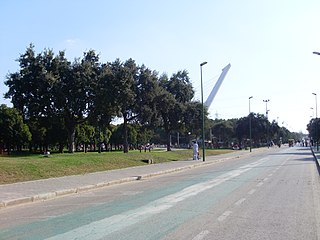 W
WThere are sixteen national parks in Spain: ten in the Iberian Peninsula, four in the Canary Islands and one in the Balearic Islands. Twelve of the seventeen autonomous communities of Spain have national parks. Canary Islands has the most (four), followed by Andalusia (three), Castile-La Mancha and Castile and León. There are five autonomous communities that have no national parks: Basque Country, La Rioja, Murcia, Navarre, Valencian Community.
 W
WThe National Parks of Spain are set out in the following table in alphabetical order. They are defined under Spanish Law 41/1997, which established a new model of shared management of the national parks between the National and the Regional Governments.
 W
WThe Alameda de Hércules , or simply La Alameda, is a garden square or mall in Seville, southern Spain. Built in 1574, it was originally a promenaded public garden, named after the eight rows of white poplar trees that fill its central part. Located in the northern half of the city's casco antiguo, between the Guadalquivir River and the Macarena neighbourhood, it was the oldest public garden in Spain and Europe.
 W
WAlamillo Park is a metropolitan park located between the town of Santiponce (Sevilla) and Seville, Spain. The park is scheduled to begin an expansion that will make it one of Spain's largest urban parks, reaching 120 hectares in the summer of 2013.
 W
WCastelar Park is located in Badajoz, in Extremadura, Spain. Situated south of Guadiana River, its features include tall palm trees and a central pond, frequented by ducks and pigeons; peacocks wander around the park. There are monuments dedicated to the romanticist writer Carolina Coronado, who lived in Badajoz, and to Luis Chamizo Trigueros, who was born in Guareña. Although Castelar remained neglected for many years, it was renovated during the tenure of Mayor Miguel Angel Celdran Matute (1996-present), making it a venue for fairs, exhibitions, entertainment and leisure. Parque Infantil (Playground) is located across the street.
 W
WThe Citadel of Pamplona or The New Castle is an old military renaissance fort, constructed between the 16th and 17th centuries in the city of Pamplona, the capital of the Navarre Community (Spain). At present a large part of the fort it is still standing in a public park with cultural activities taking place in its buildings.
 W
WDoña Casilda Iturrizar Park is a public park located in the city of Bilbao, in the central neighbourhood of Indautxu. It is named after Casilda Iturrizar, who donated the land and was a prominent philanthropist in the city.
 W
WLa Florida is a park in Vitoria-Gasteiz, Álava, Spain. It was built between 1820 and 1855 in neoclassical style by the architects Angel Chavez, Juan De Velasco, Ramón Ortés De Velasco and Manuel Arana. The birth of Florida is dated 1820 when they built the existing ring that surrounds the music kiosk. For the actual 32,454 square meters land used the former convent of Santa Clara, and as much as planners have insisted later, there is nothing similar in the new green spaces in Vitoria.
 W
WMonasterio de Piedra is a monastery, hotel and park complex in the Iberian System mountain ranges, near Nuévalos, province of Zaragoza, Aragon, Spain. The monastery was founded in 1194 by Alfonso II of Aragon, with thirteen Cistercian monks from Poblet Monastery, in an old castle next to the Piedra River, and was dedicated to St. Mary the White. On February 16, 1983, the entire complex was declared a national monument.
 W
WMount Cobetas is a mountain in the city of Bilbao, Spain. It is located southwest from the city center and stands 205 m (673 ft) high. It raises between the neighborhoods of Altamira and Zorroza, both located in the district Basurto-Zorroza. It was refurbished in 2005 and became the largest park of the city, with an area of 18.5 ha. On the top stands the ruins of the Altamira Fort, used during the Spanish Civil War.
 W
WPagoeta Nature Reserve is located near the town of Aia in the Basque Province of Gipuzkoa, Spain.
 W
WThe Park Federico García Lorca is a park situated in Camino de Ronda, Granada, Spain. It is named for the Spanish poet Federico García Lorca. It is designed with many sunny alleys and palm trees.
 W
WThe Parque de María Luisa is a public park that stretches along the Guadalquivir River in Seville, Spain. It is Seville's principal green area.
 W
WPinar del Rey is a public park in San Roque, Cádiz in the south of Spain, with mainly pine trees. The Alhaja stream runs through the park.
 W
WThe Plaza de España is a plaza in the Parque de María Luisa, in Seville, Spain. It was built in 1928 for the Ibero-American Exposition of 1929. It is a landmark example of Regionalism Architecture, mixing elements of the Baroque Revival, Renaissance Revival and Moorish Revival (Neo-Mudéjar) styles of Spanish architecture.